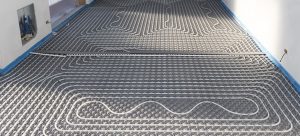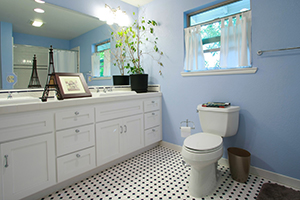
Radiant heating is an old yet energy-efficient heating method that has existed for many years. Recently, the term “radiant heating” is used more to refer to the radiant heating systems some people are installing in their flooring as an added heating component. Radiant heating has been used long before that to heat an entire home or building. Compared to your traditional forced-air systems that use heat pumps and furnaces, a radiant heating system functions very differently. A radiant heating system passes heat through your house using radiation (not the nuclear kind). Your home and your family are heated much sooner, utilizing this method of heating as opposed to a forced-air unit. When it comes to this type of heating system, there are three basic categories: electrical radiant systems, hydronic or water-based radiant systems, and air-based radiant systems. Learn all about each of these different types of radiant heating below!
1 – Electric Radiant Heating Systems
An electrical radiant heating system uses electric coils that produce heat as electricity passes through them. These metal coils resist electricity. That resistance emanates heat when electricity passes through the coil. We wrap polymer sheets around these coils to act as insulation. They can heat the ceiling wall or floor, as mentioned before, depending on their location. This method of radiant heating is the go-to method for floor heating.
While this method of radiant heating system is usually minimally demanding maintenance wise, lasting longer than it’s alternatives, they can cost a pretty penny to run because of the always increasing cost of electricity. They are usually more energy-efficient if used in small areas of a home like a bathroom or a driveway.
2 – Hydronic Radiant Heating Systems
Hydronic radiant heating systems use a boiler to pump heated water through a network of pipes throughout a house or floor. You can also install them in ceilings and walls. While they are cheaper to operate than electrical heating systems, they run a risk of bursting or leaking pipes. For heating your entire home though, hydronic radiant heating systems are the most energy-efficient and cost-effective.
3 – Air Radiant Heating Systems
As you might guess, air radiant heating systems use heated air for heat transfer. Of the three standard radiant heating systems, these are the least efficient. Their lack of efficiency is due to the fact that air has the least capacity to carry and retain heat. This is especially so if you live in an older home with potentially more areas of your home with air leaks or cracks that can waste the heat.
If you’re interested in a radiant heating system or any other type of heating system for that matter, United Heating and Air is your number one HVAC contractor in Southern California. Our knowledgeable staff is on call 24/7, ready to service your existing heating system. We can also answer questions about installing a new and energy-efficient or repair heating system in Escondido and Encinitas. We carry the top brands in all heating and cooling systems and offer affordable, upfront quotes for any budget or house.





